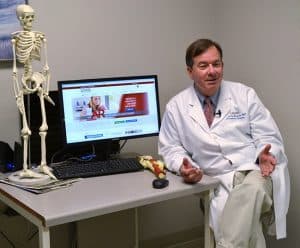View Larger Image

Charles Pearce, M.D. was back to work four weeks after having his knee replaced.
Orthopaedic Surgeon Mends Friend and Colleague
| Orthopaedic surgeon Charles Pearce, M.D. joins a chorus of other happy patients when he says he would have had his knee replacement years ago if he knew how smooth the recovery would be. Pearce had been in pain for decades and learned to live with the discomfort until it became debilitating this year.
“I injured my knee in high school playing football,” he said. “I tore my ACL and menisci. I did okay for several years, running and playing basketball. But when I reached my 30s and 40s, the pain really started to slow me down.”
Eventually, Pearce was unable to swing a golf club without pain. He had trouble walking the halls in the clinic or standing for long periods during surgery. Pearce’s surgical practice was performing minimally invasive shoulder and knee surgery such as rotator cuff tears and knee tears, not knee replacements.
“I considered getting my knee replaced, but I thought I was too young. I wanted to wait a few more years. But it got to where I really couldn’t do anything,” Pearce said. “I was walking so slowly that people on walkers would pass me in the hallways.”
Pearce and the chair of the UAMS Department of Orthopaedic Surgery, C. Lowry Barnes, M.D., have been friends since 1978. The two met in college, remained friends through medical school, and even worked together as resident physicians and in private practice.
“He is one tough cookie,” Barnes said. “but his pain got to the point where he couldn’t do the things he wanted. He was actually on my surgery schedule a couple of times, but he chickened out. Ha! Chuck Pearce is one of the premier arthroscopic shoulder surgeons in the country so when he got to where he couldn’t do his job as much as he was needed, he decided to proceed with the knee replacement.”

Lowry Barnes, M.D., said joint replacement surgeries have changed drastically in the nearly 25 years he has been an orthopedic surgeon.
Barnes said surgeons used to advise patients to wait until they were older before a joint replacement to ensure it would last their lifetime.
“We now know that we can do revisions if patients were to wear out their knee replacement,” Barnes said. “Fortunately, it doesn’t happen very often. The implants are so much better and last a long time. Also, you can be very active on these implants.”
Barnes said while Pearce’s surgical case was complicated because of how much his arthritis had progressed, his recovery went smoothly. Pearce took almost no pain pills and powered through physical therapy.
“We find that patients are often concerned about the postoperative recovery,” Barnes said. “Our techniques are so much better now from surgery to pain management. Our patients typically go home the next day and they bounce back quickly.”
With his own knee patients, Pearce says he has been more encouraging for them to look into a replacement if he feels like their pain is as debilitating as his was before surgery.
“Everyone has a little apprehension,” he said. “But it was a great experience on this side of things. UAMS is second to none: informative, professional and well-organized.”
Pearce was back on the job after four weeks, but he felt well enough to go back even before that. He looks forward to getting back outdoors to hunt, fish and play golf. He also picked up a new sport. His wife introduced him to pickle ball, a paddle sport that combines elements of badminton, tennis and table tennis.
“She’s a big tennis player, very competitive,” Pearce said. “I’m happy to report that I beat her. I think I’ll keep playing, and maybe even try to hit a tennis ball.”
